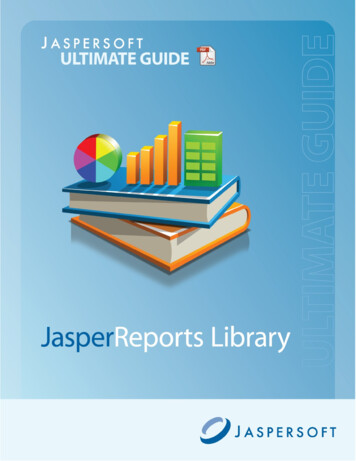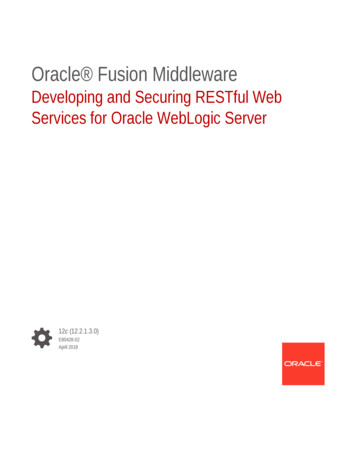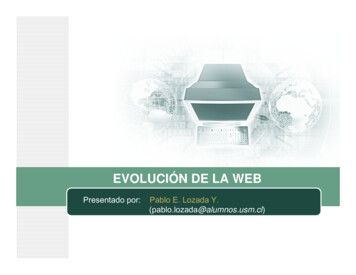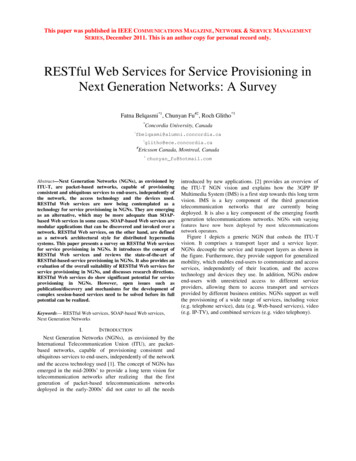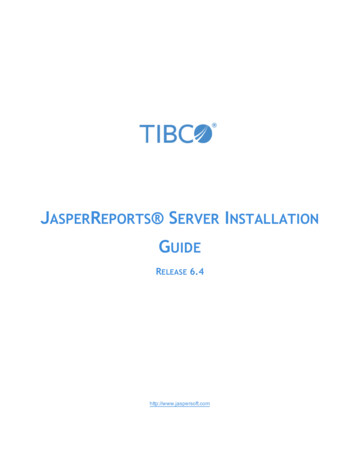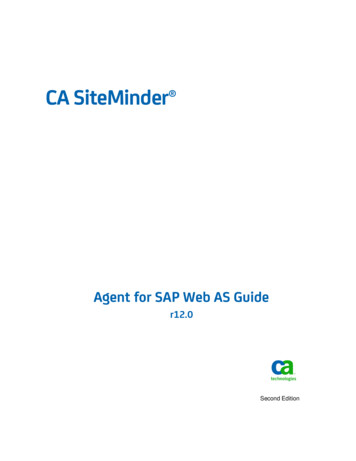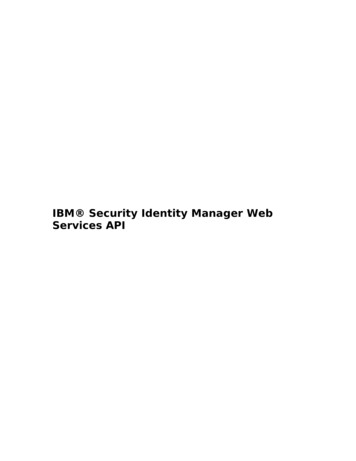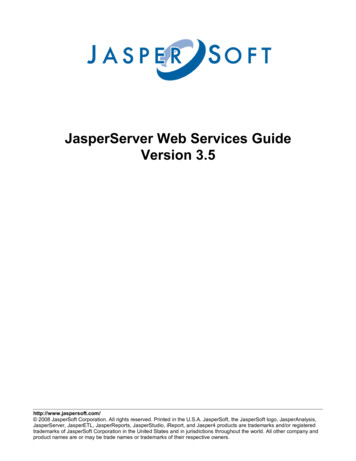
Transcription
JasperServer Web Services GuideVersion 3.5http://www.jaspersoft.com/ 2008 JasperSoft Corporation. All rights reserved. Printed in the U.S.A. JasperSoft, the JasperSoft logo, JasperAnalysis,JasperServer, JasperETL, JasperReports, JasperStudio, iReport, and Jasper4 products are trademarks and/or registeredtrademarks of JasperSoft Corporation in the United States and in jurisdictions throughout the world. All other company andproduct names are or may be trade names or trademarks of their respective owners.
JasperServer Web Services GuideTable of Contents1 Introduction.32 Repository Web Service.32.1 ResourceDescriptor.32.2 Request and Operation Result.72.3 Operations in the Repository Service.102.3.1 List.102.3.2 Get.122.3.3 Put.182.3.4 Delete.202.3.5 Move.202.3.6 Copy.202.3.7 runReport.212.3.7.1 Report Output.212.3.7.2 Report Locales.222.4 Errors and Implementation Suggestions.222.4.1 Errors.222.4.2 Implementation Suggestions.243 Report Scheduling Web Service.253.1 Types Defined in the WSDL.263.2 Operations in the Scheduling Service.273.2.1 Operation Descriptions.273.2.2 Example Request and Operation Result.273.2.3 Java Client Classes.29Appendix A Repository Service API Constants.3021007-JSP21-4
JasperServer Web Services Guide1 IntroductionThis document describes the JasperSoft BI suite’s SOAP (Simple Object Access Protocol) web services ApplicationProgramming Interface (API). It describes the functionality provided in both Open Source and Professional editions.JasperServer offers these web services: The repository web service lets you explore the repository, modify report units and several other resourcetypes, and run reports with or without input parameters. The scheduling web service lets you schedule reports, retrieve information about jobs, and to delete them.The web services take as input an XML document (the request), and return another XML document as the result (theoperation result). Because they use XML, the web services provide easy, natural integration with the most commonprogramming languages and environments.JasperSoft provides two complete sample applications that demonstrate the API: a simple J2EE (Java 2 EnterpriseEdition) web application and the same application written in PHP (PHP Hypertext Preprocessor).By default, the web services are available at the following URL:EditionWeb ServiceURLJasperSoft Open r-pro/services/ReportSchedulerJasperSoft Professionalwhere localhost is the name of the computer hosting JasperSoft and 8080 is the port you specified during installation.Note: The context name (jasperserver or jasperserver-pro) may also depend on the specific installation ofJasperServer.You must supply a valid account to access the web services. The web services accept the same accounts andcredentials as the JasperSoft web interface.To simplify life for Java developers, JasperSoft provides a set of helper classes, including a ready-to-use client thatcan make it easier to integrate an external application with JasperServer, be it web- or desktop-based. These classesinclude an object model that represents resources and creates requests and operation results, along with a Marshallerand an Unmarshaller class to quickly move between XML and the Java object model. The presentation of eachservice includes code samples that show how to use these classes.2 Repository Web ServiceThe repository web service is comprised of seven methods: list, get, put, delete, move, copy, and runReport.You can retriece the WSDL document that describes the repository service by invoking the URL of the service andappending the string ?wsdl to it. For s/repository?wsdlThe complete WSDL is detailed in Appendix A “Error: Reference source not found” on page Error: Referencesource not found.2.1 ResourceDescriptorResources (such as reports, images, and queries) are stored in a repository, which is organized like a file system, witha root and a hierarchical set of folders. Each object in the repository is considered a resource: a folder is a resourceof type folder, a JRXML resource is a resource of type file, just as images and JAR files are of type file. Someresources are more abstract, such as connection definitions and an input controls. The repository web serviceoperates on all resources.A resource is identified by:3
A name. A label. A unique Uniform Resource Identifier (URI) that defines the location of the resource in the repository. AnURI is similar to a Unix path (for example, /samples/reports/AllAccounts).A resourceDescriptor tag is defined by the following DTD (Document Type Definition): !ELEMENT resourceDescriptor (label, description?, resourceProperty*, resourceDescriptor*,parameter*) !ATTLIST resourceDescriptorname CDATA #REQUIREDwsType CDATA #REQUIREDuriString CDATA #REQUIREDisNew ( true false ) false !ELEMENT resourceProperty (value?, resourceProperty*) !ATTLIST resourcePropertyname CDATA #REQUIRED !ELEMENT value (#PCDATA) !ELEMENT parameter (#PCDATA) !ATTLIST parametername CDATA #REQUIREDisListItem ( true false ) false The wsType attribute defines the nature of the resource. Currently, the possible values for this attribute are:ValueDescriptionbeanSpring bean data sourcecontentResourceThe output of a report.datasourceGeneric data source. This type is normally used for a data source ReportUnit childresource when the is not defined locally to the ReportUnit.dataTypeDatatype (used with the input controls)folderFolderfontFont file (normally a True Type font)imgImage fileinputControlInput controljarJAR filejdbcData source of type JDBCjndiData source of type JNDI4
JasperServer Web Services GuideValueDescriptionjrxmlJRXML source filelovList of values (used with the input controls)olapMondrianConOLAP Mondrian connection – a direct connection to an OKAP source.olapMondrianSchemaOLAP Mondrian SchemaolapXmlaConOLAP XMLA connection – a remote connection to an OLAP source.propResource bundle file (normally ending with .properties) for specific reportsqueryQuery used to retrieve data from a data sourcereferenceReference to another resource. References are present only into report unitsreportUnitA complete report that can be run in JasperServerxmlaConnectionXMLA ConnectionFor all the other resource types found in the repository, the repository web service sets the attribute wsType tounknown.The isNew attribute is used with the put operation to indicate whether the resource being uploaded is new orreplaces an existing resource in the repository.A resource can have a set of properties depending on its type and a set of children resources. Finally, a resourcedescriptor can contain one or more parameters: their use is not intended to describe the resource; they store thevalues users select when the runReport service is invoked.A resourceProperty is normally a simple pair of a name and a value. The Java domain.impl.ResourceDescriptor containsconstants for each property name. JasperSoft may add further constants in future releases.The following resourceDescriptor sample contains a set of simple properties; it describes a JDBC connectionresource:5
resourceDescriptorname "JServerJdbcDS"wsType "jdbc"uriString "/datasources/JServerJdbcDS"isNew "false" resourceProperty name "PROP DATASOURCE DRIVER CLASS" value com.mysql.jdbc.Driver /value /resourceProperty label JServer Jdbc data source /label description JServer Jdbc data source /description resourceProperty name "PROP PARENT FOLDER" value /datasources /value /resourceProperty resourceProperty name "PROP VERSION" value 0 /value /resourceProperty resourceProperty name "PROP DATASOURCE PASSWORD" value password /value /resourceProperty resourceProperty name "PROP DATASOURCE USERNAME" value username /value /resourceProperty resourceProperty name "PROP DATASOURCE USERNAME" value username /value /resourceProperty resourceProperty name "PROP DATASOURCE CONNECTION URL" value jdbc:mysql://localhost/test?autoReconnect true /value /resourceProperty /resourceDescriptor Some properties cannot be represented by a simple value. To accommodate more complicated properties, aresourceProperty can recursively contain other resourceProperties. This is the case for a List of Values resource: thevalues are contained in the resourceProperty named PROP LOV and are represented by sub-resourceProperties. Forexample: resourceDescriptor name "SampleLOV" wsType "lov" uriString "/datatypes/SampleLOV" isNew "false" label Sample List of Values /label resourceProperty name "PROP RESOURCE TYPE" value main.ListOfValues /value /resourceProperty resourceProperty name "PROP PARENT FOLDER" value /datatypes /value /resourceProperty resourceProperty name "PROP VERSION" value -1 /value /resourceProperty resourceProperty name "PROP HAS DATA" value false /value 6
JasperServer Web Services Guide /resourceProperty resourceProperty name "PROP IS REFERENCE" value false /value /resourceProperty resourceProperty name "PROP LOV" resourceProperty name "US" value United States /value /resourceProperty resourceProperty name "CA" value Canada /value /resourceProperty resourceProperty name "IN" value India /value /resourceProperty resourceProperty name "IT" value Italy /value /resourceProperty resourceProperty name "DE" value Germany /value /resourceProperty resourceProperty name "RO" value Romania /value /resourceProperty /resourceProperty /resourceDescriptor Notice that, for each list item, the resourceProperty name represents the item value, and the resourceProperty valuecontains the item label.When a resourceDescriptor is used as an input parameter in a request document (for example, to specify a folder tolist or a file to download), the description includes only a small portion of the entire resource descriptor definition:the part that describes the specific details of the resource in question can be ommitted. In many cases, the onlyinformation required to identify a resource in the repository is the wsType, the name, and the URI.The resource descriptor is a complex structure that transfers data regarding a specific resource between the serverand the client. A request can include only one resource descriptor. Often, the request only includes a small portion ofthe entire resource descriptor definition: the part that describes the specific details of the resource in question.The resource descriptors that the server sends are completely populated with all the data about the resources beingdescribed.2.2 Request and Operation ResultThe repository web services operation takes a single input parameter of type string. This XML document representsthe request. The following shows its DTD: !ELEMENT request (argument*, resourceDescriptor?) 7
!ATTLIST requestoperationName (get list put runReport ) "list"locale #IMPLIED !ELEMENT argument (#PCDATA) !ATTLIST argumentname CDATA #REQUIRED A request is a very simple document that contains: The operation to execute (list, get, put, delete, move, copy, or runReport). A set of optional arguments. Each argument is a pair of a key and a value that is used to achieve very particular results; arguments are only used rarely. A resource descriptor.The operation name is redundant, since the operation to execute is intrinsic in the invoked service. Howeever,including the name can clarify the request document.The services act on a single resource at time. The resource that is the subject of the request is described by aresourceDescriptor.To get error messages in a particular locale supported by the server, specify the locale code with the localeattribute. Locale codes are in the form language code [ country [ variant ]. Valid examples include en,en US, it IT, and ro. For a list of Java-compliant locales, please refer to Sun’s Java web site.The following sample request lists the repository root: ?xml version "1.0" encoding "UTF-8"? request operationName "list" locale "en" resourceDescriptor name "" wsType "folder" uriString "/" label null /label /resourceDescriptor /request Executing a service produces the operationResult in the form of a new XML document.The DTD is very simple: !ELEMENT operationResult (code, message?, resourceDescriptor*) !ATTLIST operationResultversion NMTOKEN #REQUIRED !ELEMENT code (#PCDATA) !ELEMENT message (#PCDATA) The operation result contains a return code, an optional return message and zero or more resource descriptors. Areturn code other than 0 indicates an error, which is normally described in the message tag.8
JasperServer Web Services GuideThe operation result always includes the version attribute: it can be used to detect the server version. For example,you can list the repository root and read the version set by the server in the response. In this case, we aren’tinterested in the root folder’s content: we just want the version information from the response object itself.The operation result of such a request is: operationResult version "1.2.0" returnCode 0 /returnCode .several resource descriptors. /operationResult 9
2.3 Operations in the Repository Service2.3.1ListThis service lists the contents of the specified folder or report unit. The following sample request lists the contents ofthe /ContentFiles folder in the repository: request operationName "list" locale "en" resourceDescriptor name "" wsType "folder" uriString "/ContentFiles" isNew "false" label null /label /resourceDescriptor /request Sample response: operationResult version "1.2.0" returnCode 0 /returnCode resourceDescriptor name "html" wsType "folder" uriString "/ContentFiles/html" isNew "false" label html /label resourceProperty name "PROP RESOURCE TYPE" value main.Folder /value /resourceProperty resourceProperty name "PROP PARENT FOLDER" value /ContentFiles /value /resourceProperty resourceProperty name "PROP VERSION" value 0 /value /resourceProperty /resourceDescriptor resourceDescriptor name "pdf" wsType "folder" uriString "/ContentFiles/pdf" isNew "false" label pdf /label resourceProperty name "PROP RESOURCE TYPE" value main.Folder /value /resourceProperty resourceProperty name "PROP PARENT FOLDER" value /ContentFiles /value /resourceProperty resourceProperty name "PROP VERSION" value 0 /value /resourceProperty /resourceDescriptor resourceDescriptor name "xls" wsType "folder" uriString "/ContentFiles/xls" isNew "false" label xls /label 10
JasperServer Web Services Guide resourceProperty name "PROP RESOURCE TYPE" value main.Folder /value /resourceProperty resourceProperty name "PROP PARENT FOLDER" value /ContentFiles /value /resourceProperty resourceProperty name "PROP VERSION" value 0 /value /resourceProperty /resourceDescriptor /operationResult When it lists a folder, the repository web service returns a set of resource descriptors: one for each resource thatresides in the specified folder. Use / as the URI to identify the root folder.Similarly, when it lists a report unit, the repository web service returns a set of resource descriptors that contain (at aminimum) the main JRXML source file. Since a resource in a report unit can be either a local resource or a referenceto another repository resource, you should keep a few details in mind: If a report unit data source is not defined locally, its wsType is set to datasource, which does not indicate the exact nature of the resource. Its type should simply be reference, but since the data source used bythe report unit is a special child resource, it’s easy to recognize. The URI of the referenced resource is available in the PROP REFERENCE URI property. The main JRXML resource’s wsType is always set to jrxml, even if it’s a reference to an external JRXMLresource. By looking at the PROP IS REFERENCE and PROP REFERENCE URI properties, you can determine where the resource is actually stored. The PROP RU IS MAIN REPORT property identifies the mainJRXML source file of the report unit, even if the order of its children is altered. The purpose of listing a report unit is to get the list of the resources contained in the report unit. To retrievethe entire report unit (report unit resource as well as its children) at the same time, use the get service.The list operation also provides request arguments to get the list of all resources of a given type in the repository, forexample all the report units. This use of the list operation has the following syntax: request operationName "list" argument name "LIST RESOURCES"/ argument name "RESOURCE TYPE" reportUnit /argument argument name "PARENT DIRECTORY" /reports /argument /request or request operationName "list" argument name "LIST RESOURCES"/ argument name "RESOURCE TYPE" reportUnit /argument argument name "START FROM DIRECTORY" /reports /argument /request No value is needed for the LIST RESOURCES argument. The value of the RESOURCE TYPE argument can be anyvalue of wsType except folder. The PARENT DIRECTORY argument is the URI of the folder in which you want tolook for resources. If you want to look for the resources in a branch of the repository, use theSTART FROM DIRECTORY argument.11
Several Java methods in ient useLIST RESOURCES: list(String xmlRequest) - Sends any custom request, including one using LIST RESOURCES asshown above. listResources(String type) - Lists all resources of the given type in the repository visible to thelogged in user. listResourcesInFolder(String type, String parentFolder) - Lists resources of thegiven type in the folder. listResourcesUnderFolder(String type, String ancestorFolder) - Lists resourcesof the given type in the folder and the entire tree beneath that folder.There is a shortcut for the list operation to get the list of data sources available in the repository. To do so, set therequest’s LIST DATASOURCES argument to true. request operationName "list" locale "en" argument name "LIST DATASOURCES" true /argument /request Java sample code:ResourceDescriptor rd new ResourceDescriptor();rd.setWsType( ResourceDescriptor.TYPE FOLDER );rd.setUriString("/");List lst wsclient.list(rd);In the above sample, wsclient is an instance Client.PHP sample: result ws list("/");if (get class( result) 'SOAP Fault'){ errorMessage result- getFault()- faultstring;}else{ folders getResourceDescriptors( result);}This PHP sample uses the client.php file found in the PHP sample provided with JasperServer. This file defines themost important constants you may find useful when integrating with the JasperServer web services, as well as usefulfunctions that wrap the list, get, and the runReport operations.2.3.2GetThe get operation is used to obtain information about a resource. In the case of file resources, such as images, fonts,JRXML files, and JAR files, the resource file is attached to the response message.This method’s behavior differs, depending on the type of object specified: 12Generally, a simple resource descriptor is returned.
JasperServer Web Services Guide If you get a resource file, the file content is attached to the response; if you do not want the server to attachfiles to the response, set the request’s NO ATTACHMENT argument to true. If you get a report unit, all the related resources are added as child resource descriptors to the report unitdescriptor. If you get an input control that is based on a query, and you set the IC GET QUERY DATA argument to thevalid URI of a data source, that data source is used to execute the query and populate the resourcedescriptor. This can be useful when the input control must be rendered (for example, on a web page) in order to capture a value to pass when executing a report.The following sample request gets a file resource: request operationName "get" locale "en" resourceDescriptor name "JRLogo" wsType "img" uriString "/images/JRLogo" isNew "false" label JR logo /label description JR logo /description /resourceDescriptor /request The service only uses the uriString to identify the resource to get and check for access permissions. This meansthat other information present in the resource description (such as resource properties, label, and description) are notactually used or required.If a file is attached to the response, the returned resource descriptor has the PROP HAS DATA property set to true.By default, the attachments format is MIME. You can use DIME attachments by specifying theUSE DIME ATTACHMENTS argument in the request.A get call always returns a resource descriptor. If the specified resource is not found, or the user cannot access it, anerror with code 2 is returned.Java sample:String imgUri "/images/JRLogo";ResourceDescriptor rdis new ");rdis.setUriString(imgUri);ResourceDescriptor result wsclient.get(rdis, null);PHP sample: result ws get( someInputControlUri, array( IC GET QUERY DATA someDatasourceUri ) );The resource descriptor of an input control that includes data obtained by setting the IC GET QUERY DATAargument to true would be similar to the following XML: resourceDescriptor name "TEST LIST" wsType "inputControl" uriString "/MyInputControls/TEST LIST"isNew "false" label My test list /label description My test list /description resourceProperty name "PROP RESOURCE TYPE" value main.InputControl /value 13
/resourceProperty resourceProperty name "PROP PARENT FOLDER" value /MyInputControls /value /resourceProperty resourceProperty name "PROP VERSION" value 6 /value /resourceProperty resourceProperty name "PROP HAS DATA" value false /value /resourceProperty resourceProperty name "PROP IS REFERENCE" value false /value /resourceProperty resourceProperty name "PROP INPUTCONTROL IS MANDATORY" value true /value /resourceProperty resourceProperty name "PROP INPUTCONTROL IS READONLY" value false /value /resourceProperty resourceProperty name "PROP INPUTCONTROL TYPE" value 7 /value /resourceProperty resourceProperty name "PROP QUERY VALUE COLUMN" value name /value /resourceProperty resourceProperty name "PROP QUERY VISIBLE COLUMNS" resourceProperty name "PROP QUERY VISIBLE COLUMN NAME" value name /value /resourceProperty resourceProperty name "PROP QUERY VISIBLE COLUMN NAME" value phone office /value /resourceProperty resourceProperty name "PROP QUERY VISIBLE COLUMN NAME" value billing address city /value /resourceProperty /resourceProperty resourceProperty name "PROP QUERY DATA" resourceProperty name "PROP QUERY DATA ROW" value A & L Powers Engineering, Inc /value resourceProperty name "PROP QUERY DATA ROW COLUMN" 14
JasperServer Web Services Guide value A & L Powers Engineering, Inc /value /resourceProperty resourceProperty name "PROP QUERY DATA ROW COLUMN" value 738-555-3283 /value /resourceProperty resourceProperty name "PROP QUERY DATA ROW COLUMN" value Haney /value /resourceProperty /resourceProperty resourceProperty name "PROP QUERY DATA ROW" value A & U Jaramillo Telecommunications, Inc /value resourceProperty name "PROP QUERY DATA ROW COLUMN" value A & U Jaramillo Telecommunications, Inc /value /resourceProperty resourceProperty name "PROP QUERY DATA ROW COLUMN" value 564-555-6913 /value /resourceProperty resourceProperty name "PROP QUERY DATA ROW COLUMN" value Walla Walla /value /resourceProperty /resourceProperty resourceProperty name "PROP QUERY DATA ROW" value A & U Stalker Telecommunications, Inc /value resourceProperty name "PROP QUERY DATA ROW COLUMN" value A & U Stalker Telecommunications, Inc /value /resourceProperty resourceProperty name "PROP QUERY DATA ROW COLUMN" value 323-555-1226 /value /resourceProperty resourceProperty name "PROP QUERY DATA ROW COLUMN" value Mill Valley /value /resourceProperty /resourceProperty resourceProperty name "PROP QUERY DATA ROW" value A & X Caravello Engineering, Inc /value resourceProperty name "PROP QUERY DATA ROW COLUMN" value A & X Caravello Engineering, Inc /value /resourceProperty resourceProperty name "PROP QUERY DATA ROW COLUMN" 15
value 958-555-5890 /value /resourceProperty resourceProperty name "PROP QUERY DATA ROW COLUMN" value Tlaxiaco /value /resourceProperty /resourceProperty /resourceProperty resourceDescriptor name "query" wsType "query"uriString "/MyInputControls/TEST LIST files/query" isNew "false" label query /label description query /description resourceProperty name "PROP RESOURCE TYPE" value main.Query /value /resourceProperty resourceProperty name "PROP PARENT FOLDER" value /MyInputControls/TEST LIST files /value /resourceProperty resourceProperty name "PROP VERSION" value 1 /value /resourceProperty resourceProperty name "PROP HAS DATA" value false /value /resourceProperty resourceProperty name "PROP IS REFERENCE" value false /value /resourceProperty resourceProperty name "PROP QUERY" value SELECT name, phone office, billing address city FROM accounts order by name /value /resourceProperty resourceProperty name "PROP QUERY LANGUAGE" value sql /value /resourceProperty resourceDescriptor name "" wsType "datasource" uriString "" isNew "false" label null /label resourceProperty name "PROP REFERENCE URI" value /datasources/JServerJdbcDS /value /resourceProperty resourceProperty name "PROP IS REFERENCE" value true /value /resourceProperty /resourceDescriptor 16
JasperServer Web Services Guide /resourceDescriptor /resourceDescriptor The query result is a set of rows that represents the full set of possible values for the input control. For each row, therepository web service returns the value that the runReport service expects for that particular option in the inputcontrol. Each row also includes the column values that should be displayed in the input control when promptingusers.The screenshot above shows single and multiple select input controls based on queries, as they are rendered by theiReport plugin for JasperServer. When the web services run report units, the rendering of input controls is left to theclient application. The best way to proceed is: get the report unit; check for query-based input controls by looking at the PROP INPUTCONTROL TYPE resource property oreach child resource descriptor where wsType is equal to inputControl; get each query based inp
JasperServer, JasperETL, JasperReports, JasperStudio, iReport, and Jasper4 products are trademarks and/or registered . The resource descriptor is a complex structure that transfers data regarding a specific resource between the server and the client. A request can include only one resource descriptor.
